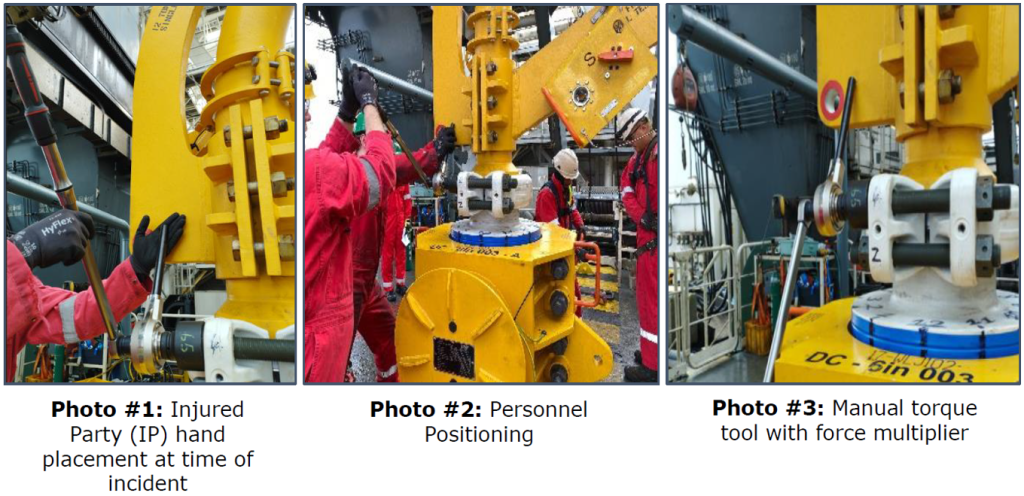Hand injury while using manual torque tool
What happened?
A deck engineer was torquing Grayloc clamp bolts connecting the gooseneck connector onto the second end of a flexible, using a manual torque wrench with a force multiplier attached. A project engineer was in the moonpool area to verify the torque settings on the wrench, as stipulated in the task plan. The project engineer stepped in to assist the deck engineer and they began torquing the bolts together. During the torquing of the last bolt, the project engineer placed his left hand on the reaction bar of the force multiplier as torque was being applied. His hand slipped and was trapped between the reaction bar and the gooseneck causing a hand injury.

What went wrong
- Those supervising and those in control of the task did not intervene when the project engineer got involved in the work;
- The pre-job briefing received by the injured person before travelling offshore did not include any advice, in terms of roles and responsibilities, on what activities project engineers do and do not get involved in;
- The project engineer who was injured was not involved in the deck engineer’s Toolbox Talk (TBT) even though he had a specific role in the task plan to verify the torque tool settings;
- The project engineer was not trained or qualified for the task he was participating in.
Lessons to learn
- Ask yourself “What should have been done differently?” to prevent this injury event?
- If it’s not safe, stop the job!
- Reinforce the expectations with supervisors to stop work if workers from outside the assigned and briefed work team become involved in the task. The natural inclination may be to offer to help: this is not always safe or appropriate;
- Ensure that the obligation and expectation to exercise stop work authority is clearly communicated and understood by all parties;
- Review inductions for new personnel travelling offshore or to site for the first time. Ensure the induction covers their specific roles and responsibilities on site;
- Ensure that ALL personnel involved in an activity are included in the toolbox talk – and that they can understand what is being discussed in the toolbox talk and what is going on in the task;
- Ensure all are aware that they should be trained on equipment before using it.
Members may wish to refer to:
- Communications: LTI finger injury during lifting operations [Roles, responsibilities, communication, and risks during lifting operations were not discussed during toolbox talk (TBT) which was held in English and translated into another language for one attendee who did not speak English]
- Near Miss: Personnel nearly struck by rotating chain attached to flexible pipe [Key people involved were inexperienced in this specific activity and were not familiar with the task in hand]
- Dropped object fell from crane – Poor communication/lack of awareness/control of work
- BSEE – “Green hats” – training and supervision of short service employees
Safety Event
Published: 24 May 2023
Download: IMCA SF 13/23
IMCA Safety Flashes
Submit a Report
IMCA Safety Flashes summarise key safety matters and incidents, allowing lessons to be more easily learnt for the benefit of all. The effectiveness of the IMCA Safety Flash system depends on Members sharing information and so avoiding repeat incidents. Please consider adding [email protected] to your internal distribution list for safety alerts or manually submitting information on incidents you consider may be relevant. All information is anonymised or sanitised, as appropriate.
IMCA’s store terms and conditions (https://www.imca-int.com/legal-notices/terms/) apply to all downloads from IMCA’s website, including this document.
IMCA makes every effort to ensure the accuracy and reliability of the data contained in the documents it publishes, but IMCA shall not be liable for any guidance and/or recommendation and/or statement herein contained. The information contained in this document does not fulfil or replace any individual’s or Member's legal, regulatory or other duties or obligations in respect of their operations. Individuals and Members remain solely responsible for the safe, lawful and proper conduct of their operations.
